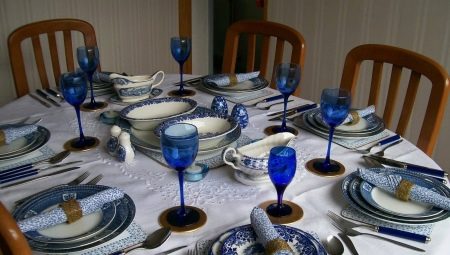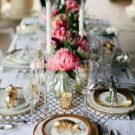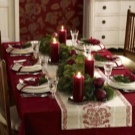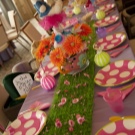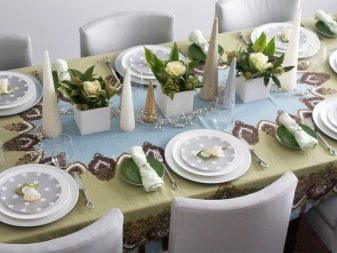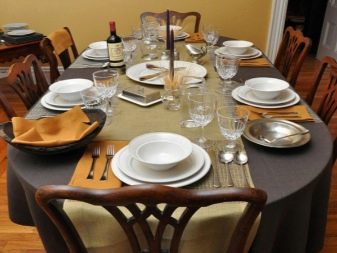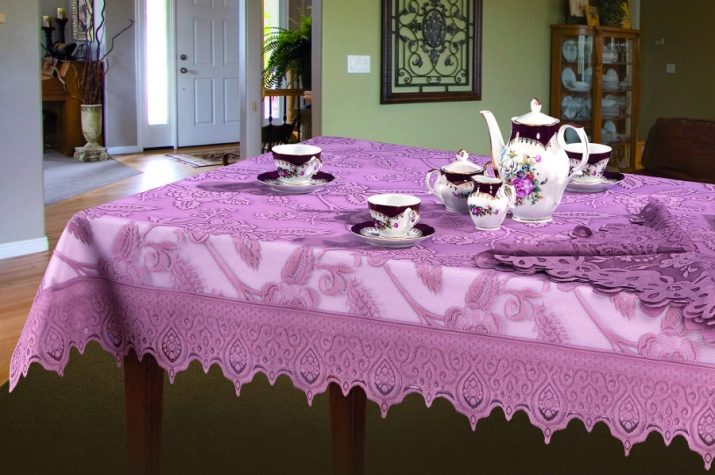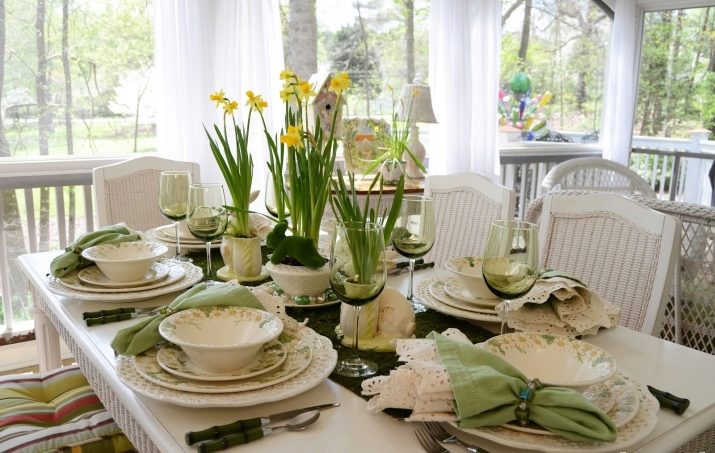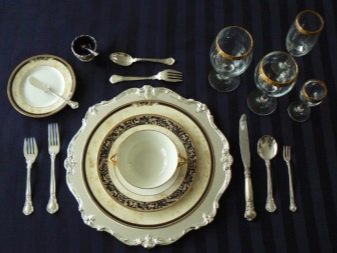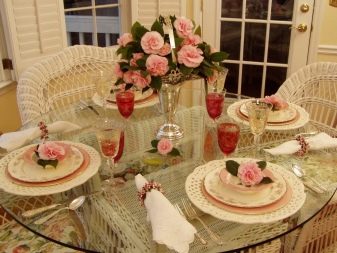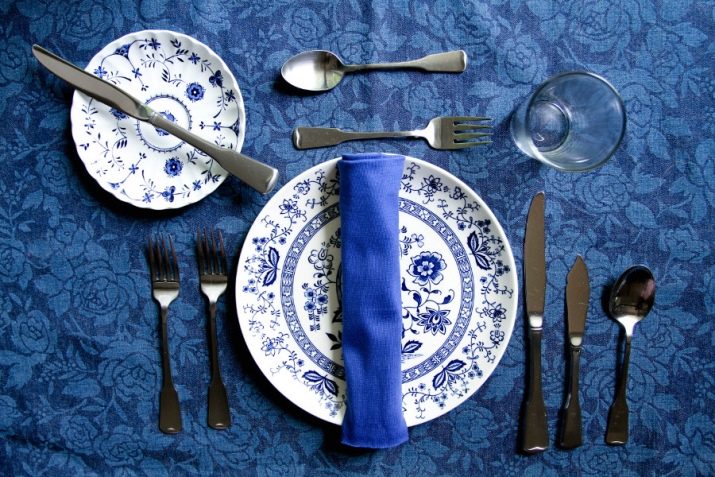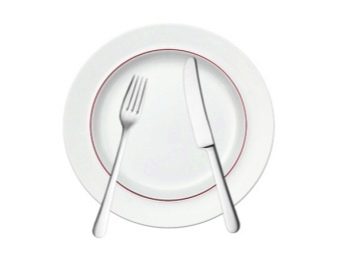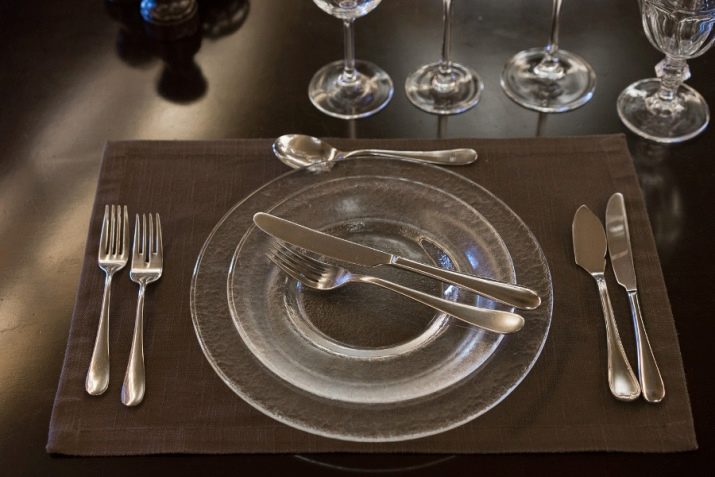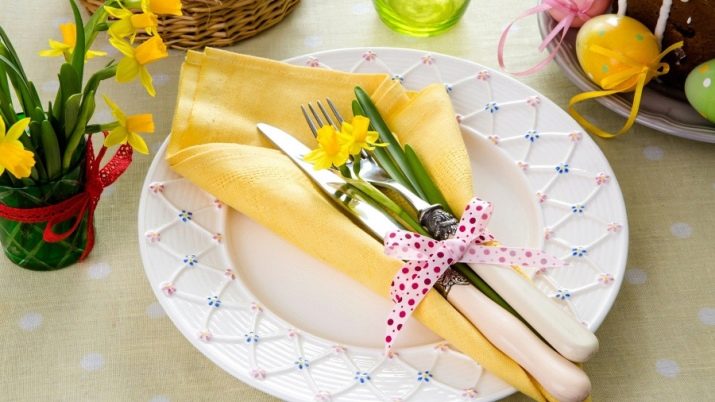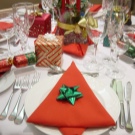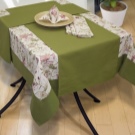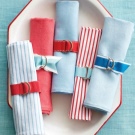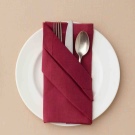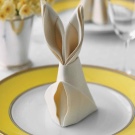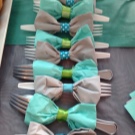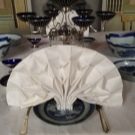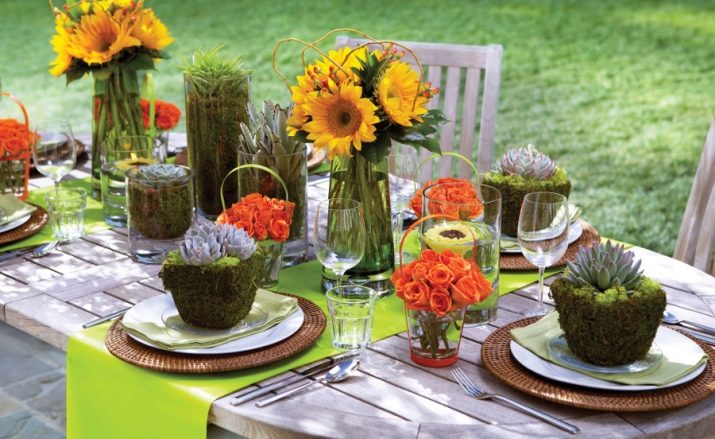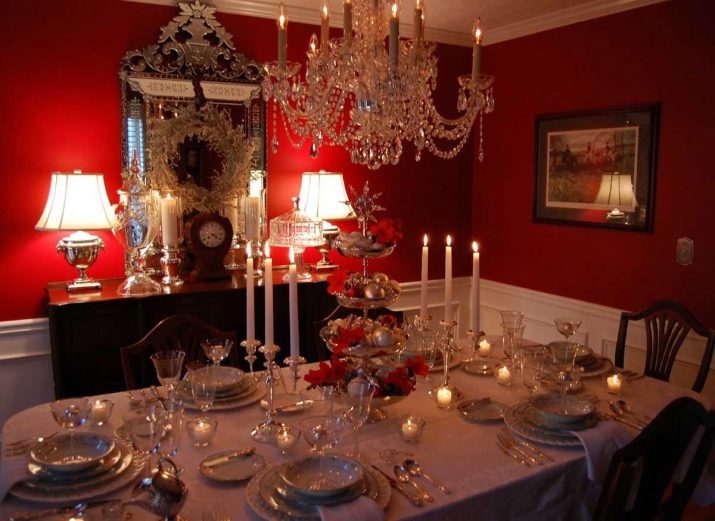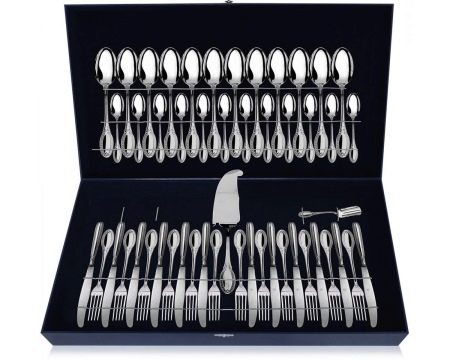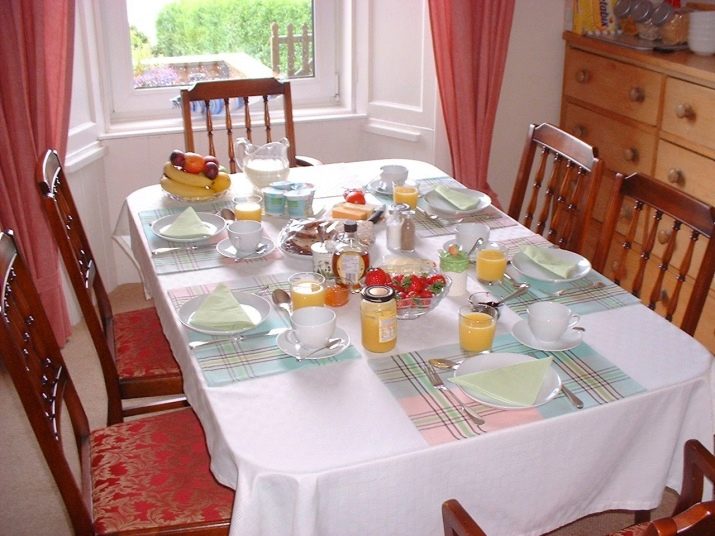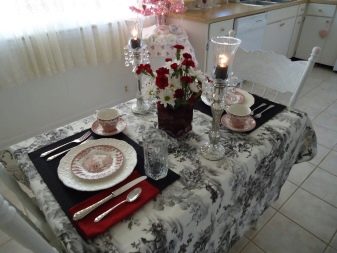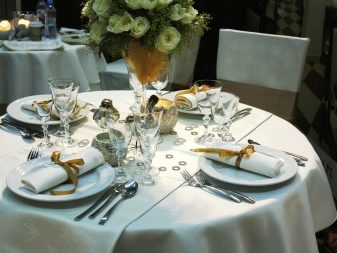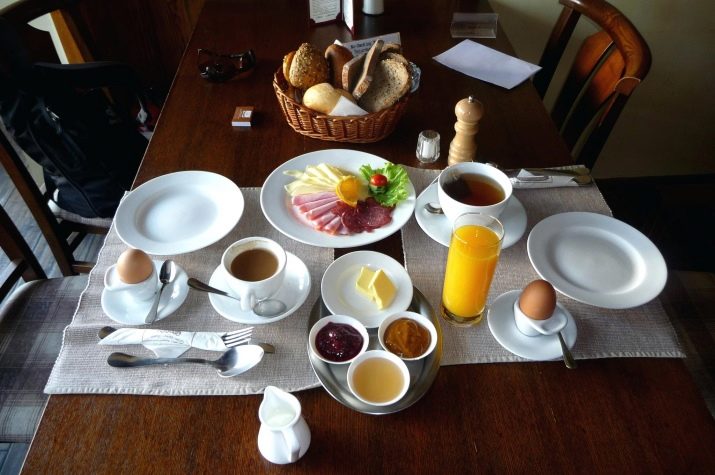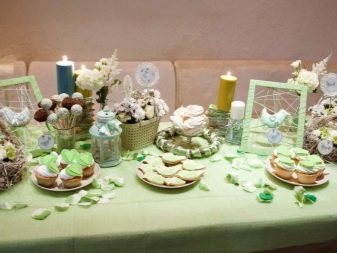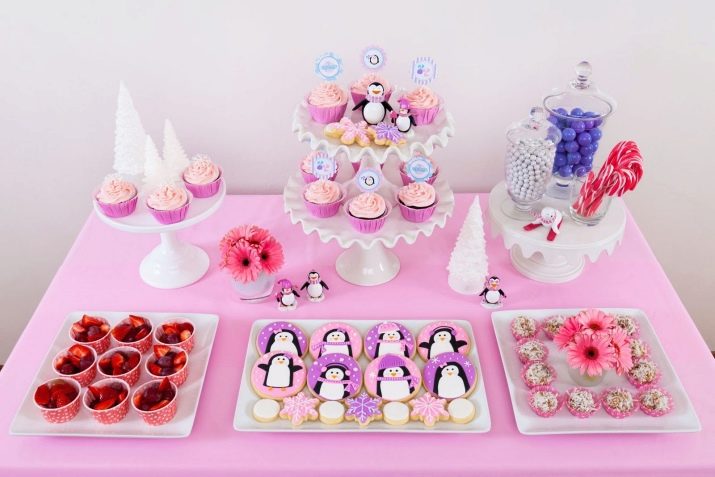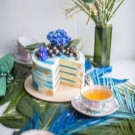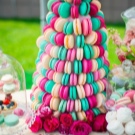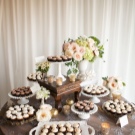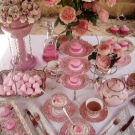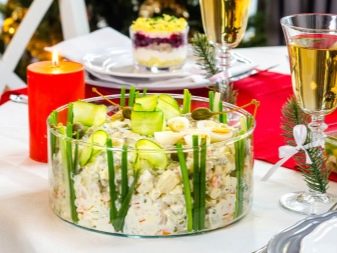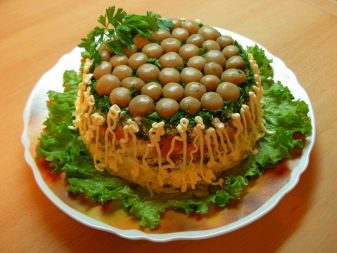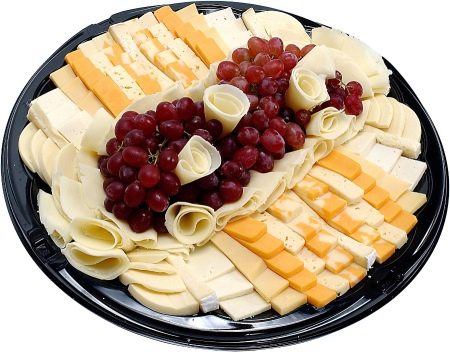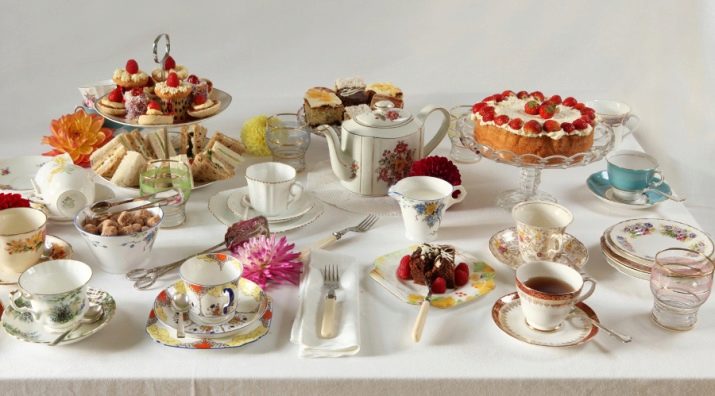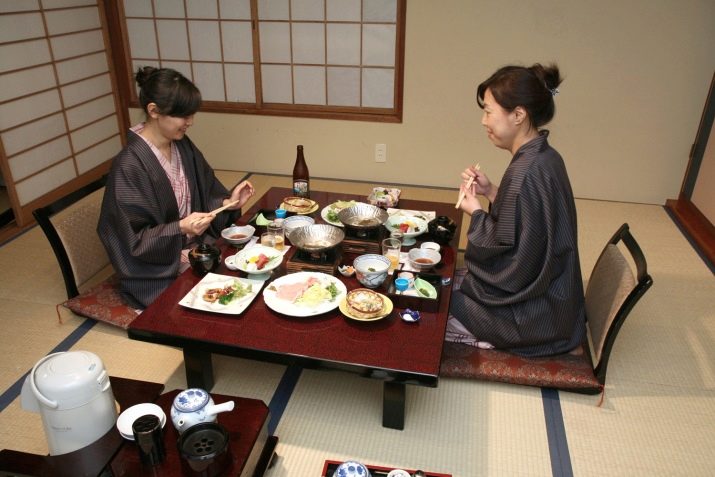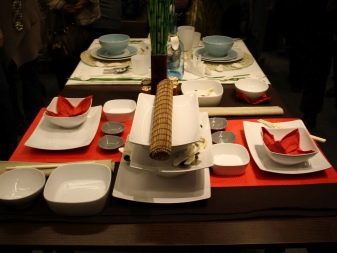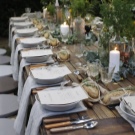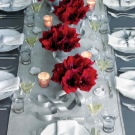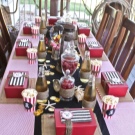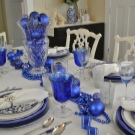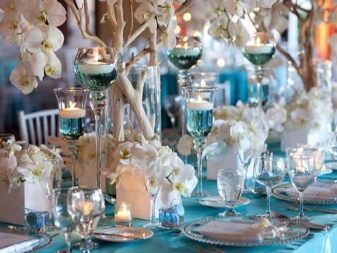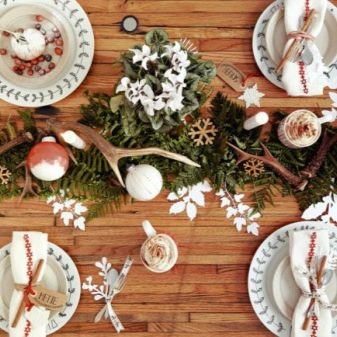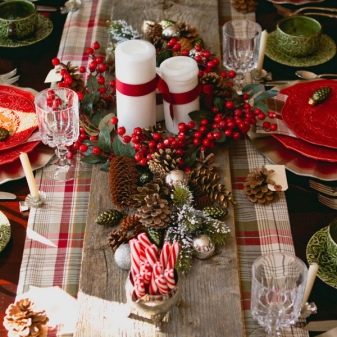Nowadays you hardly meet a family in which it would be customary to gather at a large table for a meal. The modern rhythm of life dictates its own rules, and now everything is somehow on the run: almost missing breakfast, a sneaking lunch, a dinner in front of a computer, and there is neither the strength nor the time to arrange a little holiday for yourself. And sometimes it costs. And the correct table setting always helps to catch the festive and solemn, and sometimes dreamy mood.
But what is it and how to do everything right, according to the rules of etiquette? Everything is much simpler than it seems.
Features
It seems that the table can be served either by born aristocrats or luxury waiters in the third generation, and it is not given to the common people to comprehend the secrets of the ideal location of the devices and the subtleties of different sized forks. This is a common misconception: to lay a beautiful table is much easier than cooking a tasty lunch.
It is not enough just to put a table, put a chair, scatter over the surface of a fork-spoon and remain satisfied with the created free composition.
There are certain rules for serving the table, the story of which takes place deep in the century. They should be followed in order to get a beautifully laid table over and over again. Guests will appreciate not only the taste of dishes, but also the talent of the hostess or host of the evening.
Tablecloth
Before you put the devices on the table, you need to spread the tablecloth. According to the rules of etiquette, it should hang from the table exactly 20-30 centimeters. In short, it is ugly, the whole look and style of serving is lost, and the longer it interferes with the guests. The color of the tablecloth does not dictate the rules of etiquette, so you can choose it yourself, depending on the case: concise white tablecloths for a solemn feast may be appropriate, and colorful bright or muted - for every day or for mood. The main requirement is that the tablecloth should be perfectly ironed and absolutely clean, otherwise even a perfectly laid table will look sloppy.
Nuance: let the table be only the necessary devices. After all, if there is no trace of the soup at dinner, then the capacity for it will look inappropriate and absurd and will simply be superfluous. If guests do not try fish, then devices for it will only add headache and bewilderment. Here more is not better.
Plates
At first glance, everything is difficult here. Many dishes of different sizes, which need to fit one on the other, at first scary. However, all is not so scary.
The number of cutlery is influenced by the theme of the event, the announced lunch program and the number of guests. Based on these circumstances and firmly determined with each item, you can already combine the composition of the dishes in front of each of the guests. Traditional serving rules suggest that there should be more than one dish in front of one person: a serving plate that plays the role of additional protection of the tablecloth (however, it is not necessary to use it for everyday serving), snack bar, dessert plate and soup plate (depending on the consistency of the soup is wide or a bowl).
There is one trick: in order to prevent the plates from sliding over each other, you can put a cloth or paper napkin under it: on the one hand there is a design move, on the other - the opportunity to avoid an awkward situation.
On the left side of the serving table are dessert and salad. There you can also place plates for butter and bread. The distance from the edge of the table should be about one and a half to two centimeters.
Glasses, wine glasses, glasses
Everything is quite simple here. It is not necessary to put all the devices at once - some may not be useful. At home, it is better to immediately agree with the guests about who will drink what to save themselves from unnecessary trouble.
Slightly farther than all the plates located, to the right of them we set the dishes for drinks. Here, much depends on the tastes of the guests: someone prefers red to white wine, someone stops at the champagne, and someone chooses something stronger.
There is a strict order of glasses: the smaller, the farther from the plates. In an informal setting it is possible to do without such difficulties.
The main thing is not to confuse the glasses for red and white wine, champagne glasses and all the other glasses, glasses and piles. On this depends not only the correctness of compliance with the regulations, but also the guest's pleasure: certain shapes of glasses and material (glass or crystal) help to reveal all the most subtle notes of taste and smell.
Cutlery Arrangement
At the reception, where the right and left of the plate is uncountable, at first glance, the number of cutlery, it is terrible to seem ignorant. It seems that in all the forks, spoons, never understand. But here, too, everything is simple.
There is a golden rule that is easy to remember: the farther the device is located from the plate, the earlier it will be needed.
Sort all simple: the knives are placed to the right of the plate, the forks to the left, the soup spoon next to the first knife (However, if a dessert is declared in the menu, a spoon is placed a little higher than the serving plate). And on top you can put a teaspoon.
These rules govern the following set of cutlery: fork and knife snack bars; larger appliances for the first and second courses. A fork with three to four teeth and a blade shaped knife is used for fish. Everything else in the set has a set of tools for dessert: a spoon, knife and fork.
The rules of handling devices ends with one proper arrangement of them relative to the plate. They still need to be able to use and know how to eat this or that dish.
- Soup: if there are large ingredients (vegetables, meatballs, pasta), then they should be broken in half with the side edge of a spoon. The broth from the cup can be drunk.
- Chicken: it’s better to eat it at the official dinner with the help of devices, you can only use it with family.
- Meat dishes: they are usually eaten piece by piece, and cutlets and schnitzels can be dispensed with.
- Side dishes, scrambled eggs, vegetable dishes, pasta do not require the use of a knife, but without it you should not touch the sandwiches and cakes.
- Snacks: caviar, pastes and mustard spread on bread with a special small spoon.
Probably everyone has heard something about the secret signs of cutlery. In elegant establishments with a sophisticated public, the waiter could often guess that he was satisfied with the dish not only by the visitor’s expression, but also by the position of the used appliances on or near the plate. These are certain identification marks, non-verbal symbols, which, if it is not possible to express your impression of the meal out loud, will do it for the guest.
Understanding such nuances will help to impress the strict guardians of the norms and rules of etiquette. And in order not to be trapped, inadvertently not to offend the owner and not mislead anyone, you should pay attention to and remember.
Break:
- Pause: the tips of the fork and knife lie on the edges of the plate and are slightly turned away from themselves, their handles are on the table. If a knife has not been used in a dish, the location of the fork alone is permissible.
- Waiting for the second dish: The knife and fork are perpendicular to each other on a plate, intersecting in the center: the knife is horizontal, the fork is vertical.
Completion of meal and review about food:
- I liked it: the devices lie parallel to each other, with tips in one direction.
- Did not like it: the knife crosses the fork at the teeth in the center of the plate crosswise.
- Finished: the devices lie parallel (permissible - at different edges of the dish) from each other, directly or at an angle.
By the way, on the insoluble question of where to tilt a bowl of soup during a meal: the situation when you leave a little lunch at the bottom is not forbidden by etiquette.
These signs can be useful for lunch or dinner in a restaurant, banquet or other luxurious feast, with the participation of a large number of guests, waiters and other assistants, communication with which implies the observance of distance.
In a circle of friends or at a family feast, these gestures are unlikely to be relevant. But you can always show your knowledge to your friends and hit them, and then heartily eat yummy, without burdening yourself with strict rules of etiquette.
Decor
Here only a fantasy sets limits. Depending on the subject and occasion of the feast, completely different decorations may be suitable: from light and solemn candles and strict white napkins to rough compositions from natural branches of spruce and pine cones.
Napkins
They can be different - paper, rag, color, variegated, immaculately white. In the decoration of the table, they occupy a dominant place.
Paper is one of the most appreciative materials. You can make anything of such napkins: from a simple folded triangle - timeless classics of roadside and simple cafes, to fancy cone-shaped figures, hats, swans, if you like. It is only necessary to adjust to work with delicate paper and enjoy the result.
Rag look more restrained and give any feast noble, solemn spirit. They look charmingly tied with a coarse thread, with a ring worn in the middle, or simply beautiful and unusually folded. Often you can see on the napkins of the tag with the name of the guest, who is given this place. It is both practical and stylish.
Flowers
A win-win. Suitable for large and ceremonial events, as well as for everyday table setting. The main convenience is that it is easy to reproduce a flower decoration at home and change it depending on your mood.
Mass variations: you can make a complex composition of flowers, leaves and ribbons, you can collect field and meadow flowers (actually in summer), and you can reduce everything to a minimalist style and limit yourself to thin elegant branches that emphasize the taste and style of home decoration of the set table.
Candles
The constant classic of romantic dinners and wedding feasts. Customize guests to the desired mode, being the final touch in creating the necessary holiday atmosphere. Complete and complement any composition, regardless of genre and style.
The uniqueness of candles is that they can be combined with completely different details and nuances, selecting only their shape and color in accordance with the specified parameters.
Rough thick candles of classic beige or dark shades will look great in the midst of a brutal composition that can decorate an oak table, while thin and delicate will wonderfully fit into an ensemble with fresh flowers and branches.
Attributes
When decorating a festive table you should pay attention to non-standard ways of its design. You can usually be inspired by the theme of the holiday: in the New Year, you can take artificially snow-covered spruce paws, tinsel, Christmas decorations in tone or in contrast to the tablecloth as decorations. Unusual and bold decisions - the key to success.
In the country house, you can use the real rarities: grandfathers clock, old photos, wicker openwork napkins and other things with a touch of antiquity. The summer table will be decorated with artistically scattered fruits.
Storage
Particular attention should be paid to the safety of cutlery. Any, even the most beautiful and well-assembled table setting will lose all of its appearance and shine, if the devices cannot boast of their crystal clarity and brilliance. Divorces, stains and rust can not only dull the appetite, but also kill it altogether. It is unlikely that guests will want to return to the house, which offer to use dirty spoons.
It is best to store the sets in special organizers with compartments: forks for forks, spoons for spoons, knives for knives. This is especially true of silverware. Upon completion, they should be washed in a hot soda solution and wiped with a towel to dryness - if this is not done, the silver will quickly fade and blacken from moisture, so special care is needed for such devices. However, if something went wrong and the silver has faded, it can be corrected: it is enough to prepare a mixture of tooth powder, liquid ammonia, water and soda. Mix all ingredients equally.
Everyday appliances do not require such careful care: the most common means of cleansing from grease and dirt, and washing in the dishwasher saves time and effort.
Lemon juice will become the best friend in the fight against strong pollution, and potato broth will help to return the tarnished alloy to its former shine. So devices will last a long time and will not lose their original appearance, while continuing to delight their owners.
Kinds
In serving questions, the golden rule, which was already mentioned above, remains unchanged: there should not be anything extra on the table. For fried eggs do not need a fish fork, and do not eat beef stroganoff dessert spoon. One of the serving functions is to rationalize the space on the table and create convenience for the diner.
When at the dining place everything is beautiful, then you want to enjoy food more.
For 2 and 4 persons
The most easily repeatable serving option. We are guided and fix the basic rule: on the table there is only what you really have to use for this meal and without which it is impossible to do. The rest must be removed. This, of course, does not apply to table decorations. The main requirement for them - the relevance and style.
Serving for two suggests that the atmosphere is most likely to be informal, so you can do without strict compliance with all the requirements for the laid table. It is enough to have the required number of plates (which, we repeat, depends on the proposed menu), instruments and glasses.
At the same time, it is important to take into account the shape of the table: a square or round table is perfect for sitting together for two, so that the distance between the persons is not too large, but at the same time sufficient for easy conversation.
The main thing - to withstand and maintain the mood of a good and appropriate serving. What exactly it will be: friendly, romantic, easy or playful, only two decide.
For serving the table on the fourth it is worth adhering to all the same rules. And here again the genre of the laid table dictates the relationship and the reason for gathering. Friendly meetings do not require strict adherence to the rules; rather, it will even prevent the mainstream spirit of carelessness from doing its work and helping to relax in a pleasant warm company. On the contrary, in business meetings it is better to focus on the canons of etiquette: this will help constructive conversation and focus on small details.
The table can be any, but at the same time spacious enough so that each of the guests has enough space and no one interferes with someone else’s living space.
For breakfast
In the mornings, each of us, without even noticing it, produces a mini table setting: takes out cups, mugs, plates, does everything for his own convenience. However, there are certain rules that help including optimize breakfast time.
During the morning meal, a plate of food is set in the center. On the left - a fork and a spoon, on the right - a knife. Here everything follows the golden rule of serving.
The coffee cup is placed in the right corner of the main course. On the left, as always, put a small plate for butter, bread and other additional goodies.
For dinner
In the lunch table, options already appear: someone's lunch consists of the first, second and third courses, while others are content with one dish.
The place of mugs and cups is occupied by a glass for water and a glass for wine. Drinkware is still in the same place where it is always - to the right and to the top of the main dish.
Deep plates are placed on the serving, large and flat. On the left, small but important plates for bread occupy their place of honor.
For dinner
As a rule, dinner is the most luxurious and hearty meal of the day. All things are done, you don’t need to hurry anywhere and so you can relax in the pleasant company of friends or yourself. And the table setting changes after the time of day.
Now, in front of the guest there are more glasses and glasses - for an aperitif. Appears and more cutlery, they are arranged in a classic sequence. The rest of the rules do not change: forks - on the left, knives - on the right, the farther from the dish - the earlier the device will be needed.
How to cover the holiday?
Special events require additional sections in the menu and the corresponding decoration. So, on the table may be a real path of salads or sweet treats, which takes too much space at the main table. And in serving these dishes have their own subtleties that deserve attention.
Palette
The color scheme dictates the reason.
- On a children's holiday bright, joyful and cheerful serving will be appropriate. For this purpose, perfect disposable colorful dishes - and safely, and peace of mind warms your favorite service.
- For decoration of the adult dessert table There are no special recommendations: it all depends on the wishes of the heroes of the occasion and the occasion of the holiday. The main thing - if the party is thematic, then the elements of the decoration must be consistent with this theme and be recognizable.
It is very important not to overdo it and not to turn an elegant colorful table into a vulgar tastelessness. To do this, you should carefully consider the choice of special decorations and the background of the table: it plays an important role in the formation of a whole image. The design can even use completely seemingly irrelevant items: books, mirrors, flower decorations, photo albums - all of this will serve as additional entertainment for guests when the majority of food is eaten.
Sometimes serving a sweet table implies multi-level beautiful cakes. Often they can be seen (and tried) at weddings, anniversaries, birthdays. Making such an important attribute of the holiday as a huge cake is in the first place in the setting of the sweet table.
The main thing here is a thoughtful composition. You need to decide whether it will be hooligan asymmetric or ideally adjusted, how many levels and what elements should be included in it for a more effective image of a dessert corner.
You can play not only with the vertical, but also horizontally and turn the table surface itself into a pattern or pattern. There are a lot of variations, and the only red light here can show only an exact sense of measure and style.
Menu
For sweet tooth treats should be varied. Someone from the guests can adore marmalade and hate bitter chocolate, and the other is exactly the opposite. The task of the owner - to please everyone, so you need to prepare more different sweets.
The main sweet dish is a cake. The remaining sweets play a minor role, but are necessary for tea drinking. It is important to remember that all sweets should be portioned, but it should be enough for everyone.
Sweet table is significantly different from the main. It is a misconception that he is only interested in children, so you can make it super bright. However, this is not the case. for many adult sweet teeth, the sweet table is perhaps the most important at the event.
Whether it is a children's holiday or an adult anniversary, the design of the sweet table should correspond to the stated goal. The number and variety of desserts also affects the choice of furniture. At the same time, it is necessary to immediately assess the scale of the treats and distribute the load - not so much the physical weight of kilograms of candy as their uniform distribution over the table surface: everything should be done stylishly and tastefully and cause not only appetite and bouts of greedy lust in sweet teeth, but also admiration for talent host of the evening.
Snacks - the first thing that goes. Guests whet the appetite with light tasty and simple treats. Cold dishes are for every taste and color, so that each of the invitees will find what he likes.
Everyone loves salads. Not a single feast is complete without them, and the holiday immediately ceases to be a holiday if there is not even one such dish among the treats. Therefore, they should pay special attention. As a rule, salads are served in large salad bowls, of which guests take special servings in their own plate with special devices.
They can be served not only in special containers, but even in other foods: in large lettuce leaves, inside a rolled ham or cheese slice. Stuffed vegetables and filled tartlets look cute. Such treats can be artistically decomposed on a wide flat dish.
Sausage cuts are usually laid out in several rows. As a rule, it is cut thinly and obliquely, so that on the plate it looks like flat, elongated circles. Often, to save space or when there is no place to put another plate, different sorts of meat treats are put on one in several rows, but not mixed. Boiled meat or sausage cut thicker. Decorated with parsley or dill.
Herring is served in special plates - long, elongated narrow saucers that resemble the herring itself, or other suitable dishes. Usually in the serving of such a snack they remember the silhouette of the fish and spread the pieces in a similarity to it.
Fish itself as the main dish is served in oval plates. Red fish (salted or smoked) is served sliced into thin slices. They successfully accompany a slice of lemon. Very often in the role of decoration serves fresh greens.
It is not customary to set the table with sprat and canned fish - they are simply irrelevant to such an occasion.
Cheese is either cut into thin slices and spread on a small plate, or diced into which special skewers are inserted, so that each guest can take a piece that interests him. Yes, and this feed looks more interesting and more convenient - in fact, it is not necessary to stumble a piece of cheese over four teeth of a fork over and over again and blush at its slowness.
Oysters in their natural form are served on an ice cushion with lemon as a side dish. The oyster fork, frightening from the very beginning of the meal, is on the right. Together with the oysters they serve gray bread or toast, butter.
Lobster served on a large plate. Eat it with a fork and a knife for seafood, as well as a special needle. Put a sharp angle to the fish knife. Be sure to need a bowl for washing your fingers.
Serving vegetables, perhaps the easiest action of all in the preparation of snacks. Everything is very democratic here. Small cucumbers and tomatoes are not forbidden to take hands. Large pre-served cut into slices (for tomatoes) and circles (cucumbers). They are decorated with chopped mixture of greens - onions, dill. To the red-green duet is great onions. Sliced vegetables can be sprinkled with olive or vegetable oil. Salt and pepper are usually served nearby.
Salted and lightly salted cucumbers are served cut in length. They can share one plate of sauerkraut.
As established in other countries?
Each country has its own culture, especially drinking. From here and some features of behavior at the table and differences in the rules and perception of etiquette.What is considered the norm in one country turns into rudeness and disrespect for the owner in the neighboring country.
Consider some features of the etiquette of European and Asian countries.
England
A country where etiquette and rules of decency are absorbed with mother’s milk. Tradition plays a huge role. The British are extremely scrupulous, unlike the Russians, who are concerned with the observance of these subtleties and rules - especially in such an important area as table culture.
It is not customary to begin a conversation with an unrepresented person, to keep hands on the table - they should rest on their knees. Shifting the fork and knife from right to left hand is a perfect taboo! The fork from the beginning to the end of the meal should remain in the left hand, and the knife in the right. And no exceptions.
Waiver of tea is tantamount to insulting the hosts. Therefore, it is better to stay a little longer than to pass for an ill-mannered brute.
Germany
The Germans value their own and other people's time, so being late here is deeply insulting the host. It is not accepted to appear without a gift: you must have a symbolic gift with you, like flowers. The first to sit at the table is the eldest of those present, and the right to be the first to start dinner is given to the host. If the reception takes place in a restaurant, then all those invited must necessarily wish to enjoy your meal.
It is better not to discuss personal topics at the table - in Germany you need to earn trust.
France
In France, it is customary to invite only people who have become friends, therefore, to receive such an invitation is a great honor for a foreigner. They are not as severe as the Germans for late arrivals: a delay of up to 15 minutes is considered to be a shameless one. It can be said that it is almost like to arrive on time. Shoes, by the way, at the entrance to the house to take off is not accepted.
At the table it is not customary to discuss monetary and business problems. It is better to talk about cinema, music or science. And better to keep your hands over the table.
The French have decided to eat up the dish, and the hand reaching for the salt shaker, they can consider it a downgrading of their culinary talents. When strong drinks are offered at the end of the dinner, this is a sure sign that the evening is over.
Japan
Unlike France, not to take off your shoes when entering the house is considered disrespect. Instead of a handshake - a low bow. Tardiness is perceived extremely negatively, so it is better not to risk and insult the subtle soul of the Japanese.
Before eating, be sure to wish a pleasant appetite to all those present. The Japanese judge the upbringing of a person precisely by the way he handles chopsticks. A guest waving them right and left, using them to point at others and sticking tips on food is a bad guest.
In this case, loud champing and other sounds of the meal are considered praise to the dish.. For the duration of "mooing" from the pleasure and taste of food, the host can understand how much the guest had to treat.
At the end of the dinner, you must thank the host and the chef. Leaving in Japan “in English” is considered rude.
All countries of the world have their own characteristics. Nevertheless, one thing remains unchanged: respect and reverence for the host and the guests present. Therefore, before going to a foreign country, it is imperative that you familiarize yourself with the local standards of decency and etiquette in order not to be trapped.
A selection of inspiration ideas.
Here are a few ideas that can inspire you to create an original table setting at home or demonstrate exemplary and unusual table decoration solutions.
Spring and fresh table setting for four persons for a round table. Such a serving option will remove the coolness of the present guests and give a good mood.
Pre-table setting: scheme for beginners.
Chic option full serving, made in yellow.
There are many dining table setting ideas. We give examples of how to sort the stylish and original laid tables.Bright decor with rowan sprigs and pine cones is a stunning decoration for any holiday.
Other tricks and subtleties of table setting can be found in the following video. Proper table setting is an art that can be easily learned.
